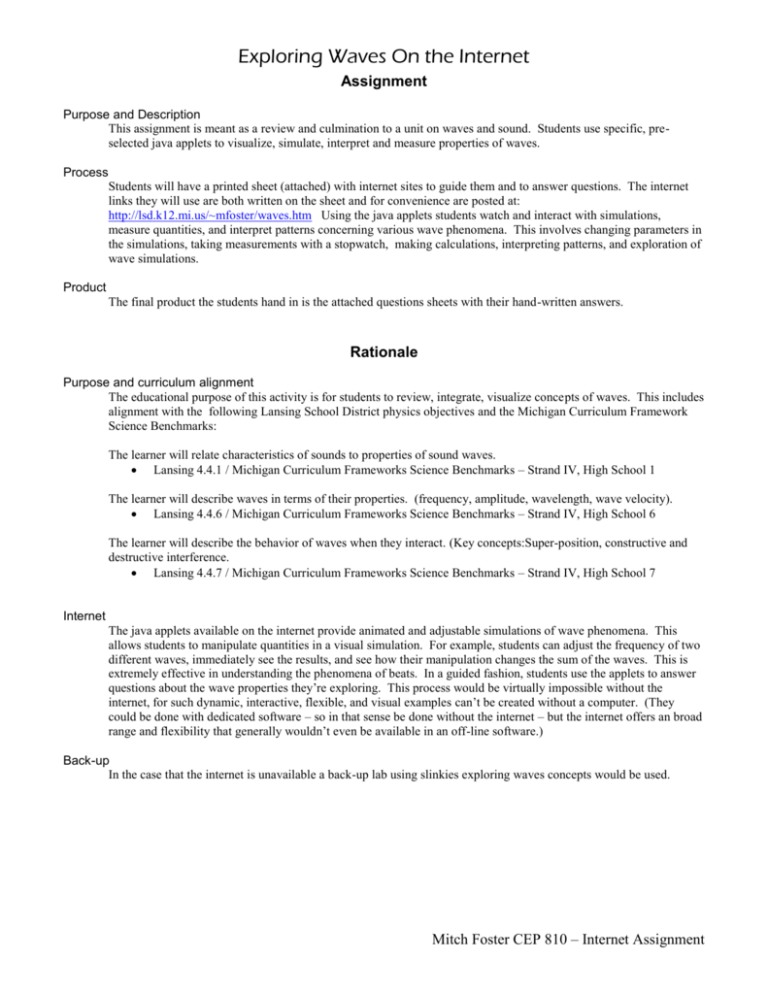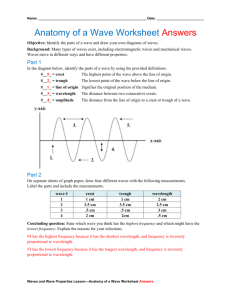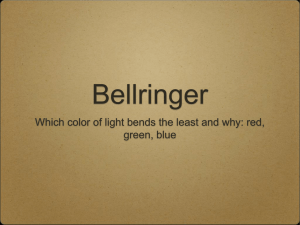Internet Wave Assignment
advertisement

Exploring Waves On the Internet Assignment Purpose and Description This assignment is meant as a review and culmination to a unit on waves and sound. Students use specific, preselected java applets to visualize, simulate, interpret and measure properties of waves. Process Students will have a printed sheet (attached) with internet sites to guide them and to answer questions. The internet links they will use are both written on the sheet and for convenience are posted at: http://lsd.k12.mi.us/~mfoster/waves.htm Using the java applets students watch and interact with simulations, measure quantities, and interpret patterns concerning various wave phenomena. This involves changing parameters in the simulations, taking measurements with a stopwatch, making calculations, interpreting patterns, and exploration of wave simulations. Product The final product the students hand in is the attached questions sheets with their hand-written answers. Rationale Purpose and curriculum alignment The educational purpose of this activity is for students to review, integrate, visualize concepts of waves. This includes alignment with the following Lansing School District physics objectives and the Michigan Curriculum Framework Science Benchmarks: The learner will relate characteristics of sounds to properties of sound waves. Lansing 4.4.1 / Michigan Curriculum Frameworks Science Benchmarks – Strand IV, High School 1 The learner will describe waves in terms of their properties. (frequency, amplitude, wavelength, wave velocity). Lansing 4.4.6 / Michigan Curriculum Frameworks Science Benchmarks – Strand IV, High School 6 The learner will describe the behavior of waves when they interact. (Key concepts:Super-position, constructive and destructive interference. Lansing 4.4.7 / Michigan Curriculum Frameworks Science Benchmarks – Strand IV, High School 7 Internet The java applets available on the internet provide animated and adjustable simulations of wave phenomena. This allows students to manipulate quantities in a visual simulation. For example, students can adjust the frequency of two different waves, immediately see the results, and see how their manipulation changes the sum of the waves. This is extremely effective in understanding the phenomena of beats. In a guided fashion, students use the applets to answer questions about the wave properties they’re exploring. This process would be virtually impossible without the internet, for such dynamic, interactive, flexible, and visual examples can’t be created without a computer. (They could be done with dedicated software – so in that sense be done without the internet – but the internet offers an broad range and flexibility that generally wouldn’t even be available in an off-line software.) Back-up In the case that the internet is unavailable a back-up lab using slinkies exploring waves concepts would be used. Mitch Foster CEP 810 – Internet Assignment Exploring Waves On the Internet Transverse Waves http://physics.cou.edu/courses/phys_222_lab3_plot1.gif Observe the animated wave. 1) What is the amplitude of this wave? 2) What is the wavelength? 3) What is the frequency (you can use a stop watch)? 4) Calculate the wave speed. (use the wave equation) Longitudinal Waves http://surendranath.tripod.com/Lwave/Lwave01.html Explore the applet. 1) Give an example of something physical that travels as a longitudinal wave. Go to the pull down menu and choose “pulsed compression” 2) If the distance across is 1 meter, use a stop watch to carefully calculate the speed of the pulse with a minimum amplitude (drag the amplitude all the way to the left). Speed = 3) Now calculate the speed of a pulse with a maximum amplitude (leave everything else the same). Does the speed of a longitudinal wave change for different amplitudes? Explain. 4) Write a conclusion about what this means in terms of sound waves. (how does amplitude relate to the sound you hear? Is the speed affected by the amplitude?) Go to the pull down menu and choose “pipe closed at left end” 5) Notice the standing wave. What kind of musical instrument might act like a pipe closed at one end? Wave Interference http://surendranath.tripod.com/Twave/Twave02.html The yellow wave is the sum or addition of the blue and red waves. Set the controls to continuous, equal amplitude, in phase. Step through the wave. 1) When does the yellow wave have the largest amplitude? 2) What kind of interference is this called (in 1)? 3) When does the yellow wave have the smallest amplitude? Mitch Foster CEP 810 – Internet Assignment Exploring Waves On the Internet 4) What kind of interference is this called (in 3) Beats http://surendranath.tripod.com/Beats/Beats.html Start with the wave in phase. The red wave + green wave = yellow wave. 1) Describe what happens to the sum (yellow wave) if the red and green wave have the same frequency. 2) Describe what happens to the sum if the red and green wave are 1 Hz apart in frequency? 2 Hz? 3 Hz? 3) The beat frequency is simply the difference in the two frequencies (of the red and green). What is the beat frequency of a 10 Hz wave with a 14 Hz wave? Try it in the applet. 4) Check the box that says, “out of phase”. Give the red and green wave the same frequency. What is going on with the superposition of these waves (the yellow wave)? Wave Superposition http://juliet.stfx.ca/~hbeltram/public/ntnujava/waveSuperposition/waveSuperposition.html Explore the applet. The black wave + blue wave = red wave. Notice constructive and destructive interference. Double Slit Wave Interference http://juliet.stfx.ca/~hbeltram/public/ntnujava/doubleSlit/doubleSlit.html Maximize the animation window. Explore the relationship of the slit distance and wavelength in terms of what kind of interference patterns occur. 1) How many “nodal” lines (complete cancellation) appear if the slit distance and wavelength are equal? 2) How many nodal lines appear if the slit difference is twice the wavelength? 3) What kind of relationship between slit distance and wavelength create the most complex interference pattern? Doppler effect http://surendranath.tripod.com/Doppler/Doppler.html Describe the difference of the wave pattern going from a velocity ratio of .9, 1, and 1.1. Create a shock wave by increasing the frequency to 5 and the velocity ratio to 1.5. If this were an airplane, and you were standing at the bottom, you would a hear a sonic boom. Fun With Digital Water http://www.javao.com/poolmenu.html Explore the effects of “water waves” and what we see. Mitch Foster CEP 810 – Internet Assignment





